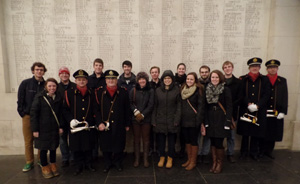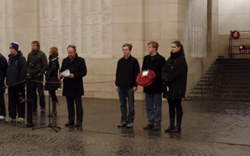Making History at the Last Post
by Stephen Norris
During the 2015 Winter Term, students enrolled in “The Great War at 100” workshop not only studied history, they made it. Three of them—Sam Colleran, Victoria Cooke, and Riley Kane--became the first Miami students to take part in the Last Post held every night in Ypres, Belgium.
Every day at 8 PM, a ceremony is held underneath the Menin Gate in Ypres. The Last Post, the traditional British bugle call, is sounded by members of the local association dedicated to remembering the Great War’s dead. The setting is a somber one: the Menin Gate was built after the war and bears the name of 54,896 British soldiers who died around Ypres and whose bodies were never recovered. Designed by Sir Reginald Blomfield and dedicated on July 24, 1927, the Menin Gate is also inscribed with Rudyard Kipling’s words: “Here are recorded names of officers and men who fell in Ypres Salient, but to whom the fortune of war denied the known and honoured burial given to their comrades in death.”
 On July 2, 1928, citizens of Ypres held the first nightly ceremony underneath the memorial. It has been held every night since, but was moved to England during the occupation of Belgium in World War II. On the day the Germans left Ypres in 1944, the ceremony was performed again under the memorial and has been held there every day since. Siegfried Sassoon, the British poet who survived his time at the front, would characterize the memorial as a “sepulchre of crime” in his poem “On Passing the New Menin Gate” and suggested that the dead “who struggled in the slime” would rise up to condemn it. The Australian painter Will Longstaff would envision something similar in his canvas, The Menin Gate at Midnight, which he completed after attending the ceremony and reportedly seeing a “vision of steel-helmeted spirits rising from the moonlit cornfields around him.”
On July 2, 1928, citizens of Ypres held the first nightly ceremony underneath the memorial. It has been held every night since, but was moved to England during the occupation of Belgium in World War II. On the day the Germans left Ypres in 1944, the ceremony was performed again under the memorial and has been held there every day since. Siegfried Sassoon, the British poet who survived his time at the front, would characterize the memorial as a “sepulchre of crime” in his poem “On Passing the New Menin Gate” and suggested that the dead “who struggled in the slime” would rise up to condemn it. The Australian painter Will Longstaff would envision something similar in his canvas, The Menin Gate at Midnight, which he completed after attending the ceremony and reportedly seeing a “vision of steel-helmeted spirits rising from the moonlit cornfields around him.” Miami students taking part in the Last Post ceremony.
Miami students taking part in the Last Post ceremony.
(L to R) Sam Colleran, Riley Kane, Victoria Cooke.
No spirits of the dead appeared around the gate on January 12, 2015, when twelve students attended the ceremony. Hosted by Miami’s Luxembourg campus, we had spent a few days in the chateau at Differdange discussing the war on the occasion of its centenary. After a 4-day study tour that brought Miami History students to Verdun, the Somme, and Ypres, we gained an appreciation for the ways the Great War continues to matter. From the landscapes still ruined by shells to the innumerable cemeteries that dot the region, the Great War remains a visible part of contemporary France and Belgium. Taking part in the Last Post proved to be the best possible reminder of this fact.
To read what the students on the Great War at 100 workshop wrote about their experiences, visit the class blog.
You can also watch four students talk about their experiences on the College of Arts and Sciences YouTube channel.

